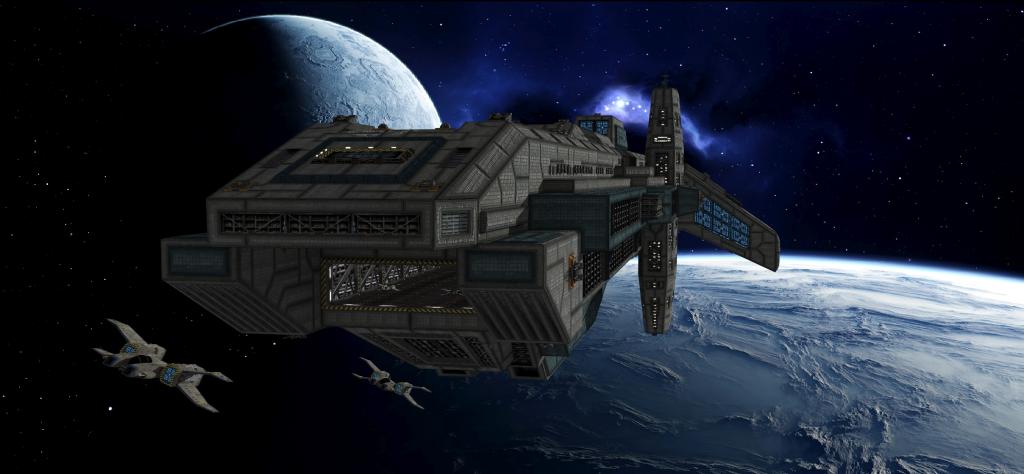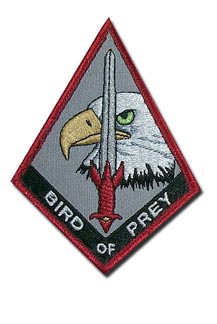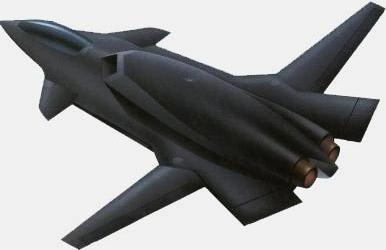
Lackland Station herself. | X-29b Bird of Prey, AKA "Switchblade." | 
Lackland Station herself. |
|---|
The X-29 Switchblade was originally created as the US Air Force’s flying Swiss Army Knife, intended as both fighter/bomber and tactical/strategic reconnaissance plane in one. This was accomplished by using a unique swing-wing design wherein the wings were attached to the fuselage at pivot points located at the REAR  | | The X-29 Bird of Prey (“Swichblade”). |
|---|
of the plane. When the wings are fully extended, the plane can fly slow enough to drop bombs precisely on their targets and takeoff/land on short runways.With the wings are swept further forward the aircraft becomes hyper-maneuverable, as the forward-swept design is inherently slightly unstable (as are their pilots). The only problem is that MOST pilots can't control the unstable aircraft; This was eventually was solved by using high-speed fly-by-wire computer systems to assist controlling the hyper-responsive wings and making the wings out of special piezo-plastic and piezo-ceramic materials that make wings, canards, and even the underside of the fuselage VERY flexible. In this configuration, it becomes a WICKEDLY agile fighter. When the wings are swept fully forward, the trailing edge of the wing converts to the leading edge, and the aircraft turns into a delta shape perfect for dashing away at speeds up to Mach 3 (and strategic reconnaissance). The result is a highly maneuverable aircraft design with a promising future for militry reconnaissance/bombers with excellent dog-fighting capabilities. This, combined with "piggybacking" on the XB-71 Aurora Space Bomber/Fighter, made it THE supreme aero-space craft. This, the Venture II Attack/Bomber, and the Indomitable-Class SSTOS, are the ONLY fully acknowledged trans-atmospheric aero-spacecraft.The Switchblade was meant to replace the F-111 fighter-bomber. At first, it was thought that the Switchblade would be a standard swing-wing plane like the F-111 it was meant to replace (going from fully back to normal), but the new design, though VASTLY more complex, was infinitely better. Switchblade is single engined and comes in two varieties, a twin seater and a single seater variant.Another first was the Chameleon Visible Wavelength Observation Limiting System; Developed BEFORE the X-29 was begun, the system didn't have a platform that could be a viable test platform; Though there were several planes that could mechanically and physically handle the load, there weren't any, until the advent of the X-29, that were perceived as being able to benefit from the system. Because of this lack, there was no operational testing of the system. Once it had been field tested, though, it's success promised far more use; Unfortunately, the out break of the Global Civil War cut short these plans until after the final end of hostilities, and several years after that, when the spy planes were suddenly re-discovered (see discussion above).The Switchblade was the FIRST aero-spacecraft equipped with space-drop re-entry shield, and in fact had a crude prototype version BEFORE "the Visitor" came. The modern version is essentially a modified DS-2 Full-Force Barrier Field which protects the underside of the craft during reentry. This development made it an ideal match for the XB-71 Aurora Space Bomber/Fighter, especially after the re-entry shield was perfected for the Aurora (shortly after the launch of the SDF-1).Name: X-29 Bird of Prey "Switchblade"Model Type: Experimental Multi-Stage, Multi-Role Attacker, Bomber, Fighter, and Strategic and Tactical Reconnaissance.Model Number: 29Crew: 2.Passengers: NONE. EVER.MDC By Location: |
Fuselage-
Cockpits (2)-
Engine Cowling-
Wings (2)- | 800
500 each
200
500 each | Variable Thrusters (2)-
Tailerons and Rudder (2 each)-
Canards (2)-
| 500 each
500 each
500 each
|
| Speed and Statistical Data: |
In the air: Mach 10.4
Range in the air: 500 miles, BUT it can be refueled in the air.
On the ground: 02 MPH
Range on the ground: 10 miles.
Height: 10 feet
Wingspan:
Open Position: 64 feet
Closed Position: 38 feet
Length: 62 feet 9 inches
Weight: 21.51 tons
Cargo: Only the pilot's emergence supplies can be carried.
Power System: A single JER-m11 Hydro-Cell Jet Engines (33,000 pounds each engine).
Flight Systems:Primary: Grav Pods.Secondary: Normal Aero-Foil effect and Hydro-Cell Jets. | Thrust Systems:Primary: A TD-001 Traction Drive.Secondary: A single JER-m11 Hydro-Cell Jet Engine (33,000 pounds).Note: Unlike other reconnaissance aircraft, the grav pods do NOT have to be shut down, as the planes do not have MRI based sensors.
Cost and Availability: Each cost 8 million credits to build; A full Squadron, 144 ships, is available anywhere at any time; There are 10 such squadron, including one full VEROCHA-Class equipped SOLELY with 2 squadrons of Switchblades.
Black Market Cost and Availability: An equivalent jet or nuclear powered system COULD be made available, but it would be VERY rare, and would not have anti-grav capability, for an estimated cost of between 250 million and 1 billion credits, depending on buyer and seller. The X-29 is actually available legally to certain groups; Mercs have managed to purchase the planes, provided they have shown "reputable business practices" in the past.
|
| Weapons Systems: |
|---|
1. Ball Turret Laser: A retractable ball turret used to discourage blind-side attacks. This is EXACTLY like the one used on the SR-71, except that the TR-3A Black Manta has TWO of them, one dorsal, one ventral.
Purpose: Defense/ Anti-Aircraft/Missile
MD: 4D6 per blast.
Rate of Fire: Per gunners attacks per melee.
Payload: Unlimited.
| 2. MRM Launchers (2): A ventral-mounted MRM Launcher is used to add to the crafts combat capabilities. This was originally the bomb bay of the B-2 Spirit Stealth Bomber, therefore no changes were made (the Spirit didn't actually drop bombs, they dropped missiles).
Purpose: Anti-Ship/Aircraft
MD and Range: Varies by type used.
Rate of Fire: Volleys of 1, 2, 3, 4, or all 5 per pilots attacks per melee.
Payload: 5 MRM's. A second and THIRD bank of missiles are kept on board, and automatically load when the previous bank has been used. |
| Features: |
- Stealth: Gives the aircraft the radar cross-section equivalent to that of a hummingbird, hides the infrared signature to that of a bad cough, and minimizes other radiation from the craft to essentially nil. The acoustic signature also has been minimized using various techniques.
- Chameleon System: Pleizio-ceramic tiles darkened or lightened as necessary to render the craft invisible. Minimum effective distance: 2 feet.
- ESM: Radar Detector. Passively detects other radars being operated.
- Radar: Combat grade radar. Range 100 miles, can track up to 50 individual targets. 95% reliability (24% against unfriendly stealthed vehicles).
- Blue Force Tracker: Identifies friend from foe. Overlays the information on both the radar and HUD, ensuring that friendly forces are not accidentally targeted.
- GPS: Standard tracking device. Ties into the Blue Force Tracker.
- Anti-Jamming System: Reduces Electronics Countermeasure by ¾ (decrease skill level appropriately).
- HUD: Displays maps, radar, targeting information, and any OTHER information the wearer wants directly in front of the user.
- FLIR/SLIR: Forward and Side Looking Infrared. Allows pilot to get visuals on targets at night.
- AJP: Active Jamming Pod. Causes -25% to detection but when it is active, other vehicles/bases can detect that it is jamming, and some missiles will home in on jamming signals. Jamming also causes a -4 penalty to all radar guided weapons. The jamming pod is only mounted inside the port taileron.
- Virtual Map: Displays a continuously-updating map of local terrain for the pilot. Takes data from and gives data to other friendly units in the area. Effective land navigation of 85% as updates come. Good to 500 miles. Specific range can be adjusted in 1 mile increments.
- Video Camera: Records from the HUD. 50 hours of recording available.
- Survival Pack: A pack of simpler emergency survival supplies: Pup tent, sleeping bag, black light, GPS, first aid kit (bandages, gauze, bandage tape, pads, antiseptic/analgesic), plasma torch (for small repairs and starting fires), repair kit (with MDC Repair Spray), sewing kit (a small spool of thread and 5 needles), 7 star flares (250 foot apogee), 2 white parachute flares (1,500 foot apogee), 100 feet of black or brown parachute cord (150 lbs tensile strength), 2-5 days rations, 2 gallons water, water purification kit- good for about 10 gallons.
- Smoke dispensers (8): Throws out smoke flares capable of obscuring IR and heat sensors, and defeats visual tracking of the vehicle. Mostly used to cover landings and takeoffs.
| - Full range optic sensory suite: Infrared, ultra violet, Magnification, night sight, color filters, thermal imager. Range is about 200 miles for MOST sensors.
- AMC/FD (2): Anti-Missile Chaff/Flare Dispensers. Actually launches a glob of burning magnesium/aluminum alloy to confuse both radar AND heat sensory systems. Fires off 04 chaff/flares each time it is activated. The system is KNOWN to work on all KNOWN radar and infrared systems, but concerns continue that somewhere out there their MIGHT be a system that will be totally unaffected by the system. Reduce effects by 20% against smart missiles (add +20% to rolls for smart missiles).
- Effect:
- 01-50 Enemy missile or missile volley detonates in chaff cloud- Missiles are all destroyed.
- 51-75 Enemy missile or missile volley loses track of real target and veers away in wrong direction (may lock onto another target).
- 76-00 No effect, missile is still on target.
- Also note that the chaff cloud will also blind nearby heat sensors (and optically based sensors at night) for 1 melee. They will suffer the following penalties: Reduce melee attacks/actions, and combat bonuses by half.
- Duration: 1D4 melee rounds.
- Payload: 60 chaff/flares. Each time the system is engaged, the system fires off 04 chaff/flares.
- Sensory Systems: The craft is equipped with sensors the likes of which no one has ever before imagined; Laser sensors that can listen in on spoken conversations, in crowded and noise-filled places; Cameras that can read the seconds on a digital wrist-watch in the dark; Signal interceptor systems that can not only eavesdrop on laser-secured radio systems, but in fact can even JAM them, causing a totally worthless signal to be received; Even a EMP-based dampening system that can tap into computers, copying all the data and leaving a blank computer in it's wake (unfortunately this does not work on hardened circuitry); Magnetic Resonance Imaging systems that can tell not only when one object is hiding amongst others (such as a power armor hiding in thick foliage with it's power plant off), but even near-alike objects intertwined (such as two different types of plants growing together); All from the edge of space.
- Chameleon System: Pleizio-ceramic tiles darkened or lightened as necessary to render the craft invisible. These tiles, in conjunction with pleizo-plastic tiles, also make the wings, canards, tailerons, and the undercarriage skin of the fuselage VERY flexible, increasing the maneuverability of the aircraft.
- Minimum Effective instance: 2,910 feet.
|
Combat Bonuses from X-29 Bird of Prey "Switchblade" Combat Elite:- 4 additional attack per melee.
- One additional Attack Per melee at levels 3, 9, and 15 with any additional bonuses for the pilot.
- +3 Initiative
- +5 Strike
- +6 Roll
- +7 Dodge
|  |
| Another Switchblade pic. |
|---|


